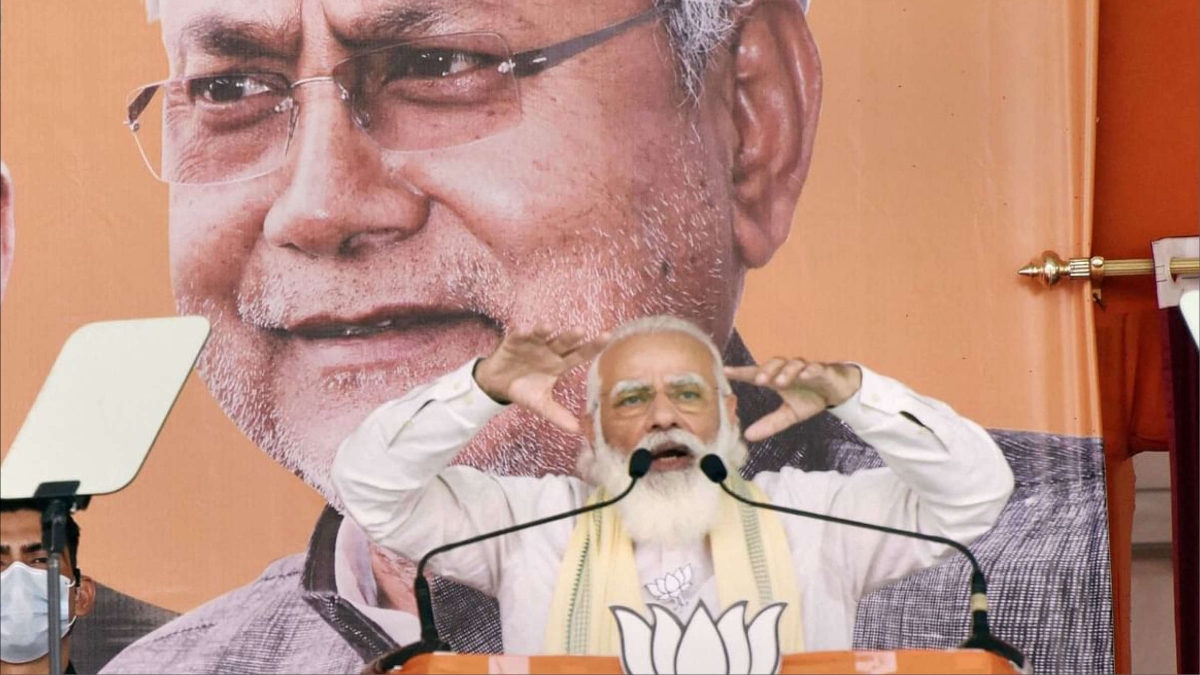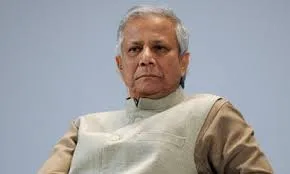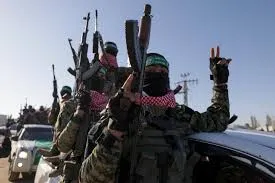On Tuesday, 10 November 2020, the commoner from Bihar and the power of the ballot outnumbered and outsmarted the Opposition, shattering the dreams of the “Double Yuvraj” duo of snatching victory from the jaws of defeat. The single biggest catalyst who ensured an absolute majority for the BJP-led NDA in the Bihar elections was, undoubtedly, Prime Minister Narendra Modi, who batted on the front foot, took the battle right into the Opposition camp, put his invincible stamp on the Hindi heartland and catapulted the scorecard of the BJP in a chain of events that jaw-dropping folklores are made of.
While the BJP bagged 74 seats, the JD(U) tally was restricted to 43. The Tejashwi Yadav-led RJD got 75 seats, but this was a fall from the 80 it had secured in the 2015 Assembly elections. Also, with the RJD contesting in 144 seats, Tejashwi’s strike declined from 79.2% in 2015 to a modest 52% in 2020, while the BJP’s strike rate was a far superior and solid 67.3%, up from the 33.75% they got in 2015. The BJP bagged 74 seats, despite contesting in just 110 seats. The analysis of vote-share showed that the RJD improved its share from 18.35% in 2015 to 23.11% this time, while the BJP saw a decline from 24.42% to 19.46%. However, the BJP was able to translate a lower vote share into higher votes due to a far better strike rate.
While the RJD’s vote share rose, its seat share fell by 6.25%, proving that the hype around Tejashwi Yadav by biased sections of the media was clearly overdone. The Congress, as is typical of it, was reduced to a mere 19 seats, with Rahul Gandhi living up to his reputation of being the driving force behind the erstwhile grand old party’s embarrassing journey into oblivion.
Political pundits, part time psephologists who never visited Bihar in the last 30 years, and the Leftist cabal completely had dismissed any chances of the NDA, pointing at the anti incumbency against Nitish Kumar. What they had never reckoned was the fact that a fifteen year anti incumbency was overpowered by the magical “pull factor” of Prime Minister Narendra Modi, a global statesman, whose towering stature has made him the most popular and powerful leader in post-Independence India.
This year the turnout of women voters in Bihar was 59.9%, as opposed to 54.7% for the men who voted. The NDA performed best in the second and third phases where the strong but “silent majority” of women voters was higher at 58.8% and 65.5%, respectively, compared to just 54.4% in the first phase. “Bihar’s villages, poor, youth, elderly, workers, shopkeepers have all kept faith with the NDA’s ‘Sabka Saath, Sabka Vishwas’ mantra,” PM Modi said in a tweet post the emphatic victory, capturing the essence of these high octane elections. He also thanked the youth and the women voters, in particular.
PM Modi’s groundbreaking schemes such as the “Ujjwala Yojana” and “Swacch Bharat” proved to be a decisive factor and led to the high turnout of women at the polling booths. Free provision of ration, that would continue till the Chhath festival, and cash transfers into the “Jan Dhan” scheme were big swing factors too. The Prime Minister’s Employment Generation Programme (PMEGP) helped women entrepreneurs set up 30,437 projects during 2016-17 and 2017-18 with financial assistance of over Rs 853.05 crore, with Bihar being a big beneficiary. Under the “Mahila Coir Yojana”, which is exclusively for rural women artisans, training in the spinning of coir yarn and various coir processing activities is imparted to rural women in regions producing coir fibre in the country. This scheme reached the hinterland in Bihar. The “Standup India” scheme, under which bank loans of between Rs 1 lakh to Rs 1 crore are facilitated, has over 81% women account holders, again with states like Bihar being big beneficiaries.
In many ways, Seemanchal is different from the rest of Bihar. The most obvious one is the demographic make-up. This area has a 47% Muslim population as against Bihar’s state-wide average of 17%. It was among the most backward regions under the “Jungle Raj” of the corrupt RJD regime prior to 2005 and was royally ignored by the political class of Patna. Purnea University, the only university here, came into existence just two years ago in 2018, thanks to the NDA. The average literacy rate of the four districts in the Seemanchal region is 54%, as against Bihar’s average of 64%. But this 54% is laudable, because fifteen years back, the literacy rate here was next to nil. Out of the 27 seats that the Congress won in 2015, 8 were from this Seemanchal region. This time, be it RJD or Congress, their politics of appeasement failed to deliver. While AIMIM, playing the minority card, did win 5 seats out of the 20 that it contested in Bihar, of which 14 were in Muslim-dominated areas, the interesting thing is that AIMIM’s strike rate has been dismal. 5 out of 20 is a pedestrian strike rate of just 25%. Minority voters who were earlier loyal to the Lalu or Congress brand of politics have been increasingly shifting their loyalties to BJP’s governance-oriented ethos, lured by Prime Minister Modi’s inclusive development agenda that cuts across caste, religious and geographical divides.
The ‘Garib Kalyan Rozgar Abhiyaan’ was launched by PM Modi in June 2020 via video conference in Katihar village in Bihar in the presence of the Chief Ministers of five states, namely, Bihar, Madhya Pradesh, Uttar Pradesh, Rajasthan, Jharkhand and a minister from Odisha. The scheme has been working on a mission mode in 116 districts across these six states where the maximum number of migrant workers returned home during the peak of the Covid pandemic. Over 20 lakh migrants of Bihari origin returned back to Bihar and were taken care of by the NDA, although the Leftist media ran a false campaign, suggesting that migrants had been left to fend for themselves. The Bihar elections have now proven how fake news and falsehoods can never trump the wisdom of the electorate.
A point less talked about is the fact that the NDA decided to extend 35% reservation to women in all categories of government jobs for which direct recruitment is made after initially implementing it only in police jobs. Amongst other things, over 42 crore beneficiaries were directly given cash support through Direct Benefit Transfer (DBT), amounting to over Rs 53,248 crores under the Pradhan Mantri Garib Kalyan Package (PMGKP), during the two months of May and June in 2020, at the height of the pandemic, with Bihar being one of the key beneficiaries.
The Modi government also transferred Rs 8,488 crore into the bank accounts of PM Ujjwala Yojana beneficiaries. Also, 8.58 crore free Ujjwala cylinders were delivered nationally, with Bihar being a key beneficiary. The Modi government also released the first installment of PM-KISAN (Rs 16,394 crore) and transferred it to over 8.19 crore identified farmers who got Rs 2,000 directly in their accounts India-wide. Again, over Rs 20,344 crore were disbursed to women Jan Dhan account holders nationally. The Bihar election results, putting the BJP in pole position, is hence a ringing endorsement of Prime Minister Narendra Modi›s excellent handling of Covid, among other things, with India›s recovery rate in excess of 93% and mortality rate at less than 1.5%. Bihar›s mortality rate is just 0.001%.
BJP›s highly erudite National President, J.P. Nadda, also played an instrumental role in the Bihar elections, which is something exemplary and needs to be documented. He covered every nook and cranny of Bihar with his fiery speeches, literally burning the midnight oil. Even in the midst of the Covid pandemic, Nadda toiled hard. He instructed every state unit to establish “Roti Banks” at the booth level and in every “Shakti Kendra” (a cluster of three to six booths) to feed migrants and daily wage workers during the nationwide coronavirus-induced lockdown. Under the indefatigable Nadda, the BJP served five crore meals every day through authenticated community kitchens at the peak of the pandemic and linked such kitchens in every block, which could serve at least 1,000 people per day.
Apart from the historic win in Bihar, driven by the Modi magic, the BJP also swept the bypolls, making clean wins in Gujarat, Telangana, Uttar Pradesh, Karnataka and Madhya Pradesh. Winning all the 8 seats in Gujarat, winning more than double of the 8 seats required to retain power in Madhya Pradesh, winning the Rajarajeshwari and Sira seats in Karnataka and, of course, scoring an unprecedented victory in the Dubakka assembly in Telangana are a glowing testimony for the charisma, connect, prowess, sway and sheer magic that Prime Minister Narendra Modi has on the electorate, across the length and breadth of India. India›s next round of elections will see the communist-ruled Kerala, the southern state of Tamil Nadu and the two eastern states of Assam and West Bengal become political battlegrounds. These states go to the polls by April-May 2021. After that, Uttar Pradesh and Gujarat will go to the polls in March and November 2022. But, for now, Bihar has sent out a strong message, very loud and clear. The ground has been laid for a powerful Modi 3.0, decisively and in more ways than one, because the Modi factor is only getting bigger.
The writer is an economist, National Spokesperson of the BJP and the bestselling author of ‘Truth & Dare: The Modi Dynamic’.























